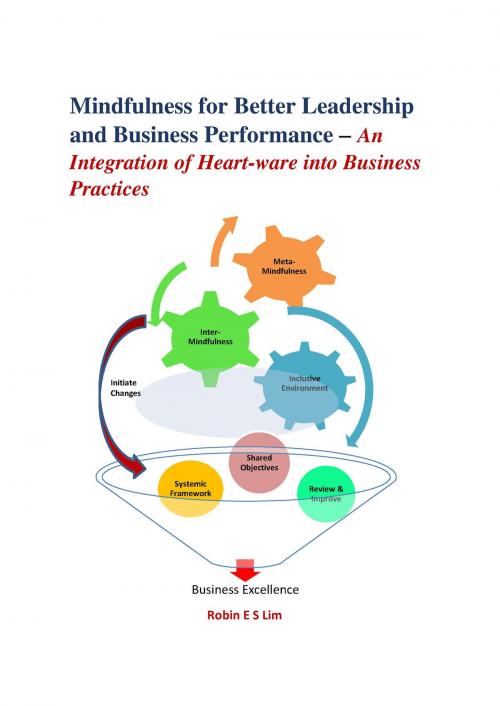Mindfulness for Better Leadership and Business Performance
An Integration of Heart-Ware Into Business Practices
Business & Finance| Author: | Robin E S Lim | ISBN: | 9789810991265 |
| Publisher: | BookBaby | Publication: | April 25, 2016 |
| Imprint: | BookBaby | Language: | English |
| Author: | Robin E S Lim |
| ISBN: | 9789810991265 |
| Publisher: | BookBaby |
| Publication: | April 25, 2016 |
| Imprint: | BookBaby |
| Language: | English |
This study aims to incorporate the positive mindset, or the so-called “Heartware,” into the software and hardware of management. This study proposes a model that crosses the disciplines of neuroscience, physiology, organisational behaviors, and management science. In the nutshell, it stresses the use of mindfulness practices to shift people’s mindsets to achieve better self-management and better relationship with others. This will develop the personal and social competencies of people. When they become leaders, they are able to foster an inclusive environment and to build a committed management team to excel the operations collectively. The proposed model uses the research findings of each of the related fields to propose a set of principles and practices. Individuals can change their mindset and behavior to become mindfulness leaders through practice. If that happens, they would be capable of fostering an inclusive environment to nurture a committed team. They can then set shared objectives, build a shared culture, and create a set of shared corporate operation systems. With such setting, the mindfulness leader and the committed team will be in the position to excel the organisation collectively. Mindfulness is a journey that needs commitment, perseverance, and resilience. It is a lifetime journey for individuals who want to be successful and to have a meaningful life. The mindfulness journey starts with people who practice mindfulness meditation and exercises. This will allow them to be calm, to notice situations with clarity, and to see things in a more objective way. People will then have the ability to assess their own strengths and weaknesses accurately. Consequently, they are more confident and capable of self-management. Regular practices of mindfulness will move people from self-management to self-exploration and to self-actualization. This is the path in the meta-continuum of mindfulness. People will become capable of adopting a “bystander” view to evaluate information objectively – something referred to as “reperceiving”. People with mindfulness practices will become more open-minded, more accepting, and more analytical of the information they receive. They will also be opened-hearted and more willing to listen and to consider different opinions and views than their own. Finally, they are prepared to step out their comfort zone and that they have the will to take action on their calling in life. This is where their personal competency is enhanced. This will also make them aware of their gaps in abilities. From there, they will continue learning. During mindfulness practice, the idea of compassion is developed. Compassion helps build the social competency in interpersonal relationship. People who are compassionate and who mindfully listen and communicate can tune their personal energy to be in line with the group’s energy. This is a sign that they are moving along the path of inter-continuum of mindfulness. They are capable of holding judgment, and they provide space for others to air their views and opinions. In effect, this will enhance their perspective and knowledge as others are sharing what they know to everyone. In doing so, everyone is learning collectively. All of these will improve the social competency of leadership. Mindfulness leaders are in a position to cultivate a set of attributes called INSPIRE (Integrity, Novelty, Sharing, People, Initiative, Resilience, and Engage) and the EACH (Engage, Accountability, Courage, and Holding space) culture. INSPIRE enhances their ability to create an inclusive environment while EACH helps foster the culture to nurture a committed team. With the participation of team members, they can set the shared objectives and systemic framework of operations together for the organisation to excel. They would also periodically review and improve their strategies, systems and shared objectives to be relevant and to prepare for the future. These will allow the organisation
This study aims to incorporate the positive mindset, or the so-called “Heartware,” into the software and hardware of management. This study proposes a model that crosses the disciplines of neuroscience, physiology, organisational behaviors, and management science. In the nutshell, it stresses the use of mindfulness practices to shift people’s mindsets to achieve better self-management and better relationship with others. This will develop the personal and social competencies of people. When they become leaders, they are able to foster an inclusive environment and to build a committed management team to excel the operations collectively. The proposed model uses the research findings of each of the related fields to propose a set of principles and practices. Individuals can change their mindset and behavior to become mindfulness leaders through practice. If that happens, they would be capable of fostering an inclusive environment to nurture a committed team. They can then set shared objectives, build a shared culture, and create a set of shared corporate operation systems. With such setting, the mindfulness leader and the committed team will be in the position to excel the organisation collectively. Mindfulness is a journey that needs commitment, perseverance, and resilience. It is a lifetime journey for individuals who want to be successful and to have a meaningful life. The mindfulness journey starts with people who practice mindfulness meditation and exercises. This will allow them to be calm, to notice situations with clarity, and to see things in a more objective way. People will then have the ability to assess their own strengths and weaknesses accurately. Consequently, they are more confident and capable of self-management. Regular practices of mindfulness will move people from self-management to self-exploration and to self-actualization. This is the path in the meta-continuum of mindfulness. People will become capable of adopting a “bystander” view to evaluate information objectively – something referred to as “reperceiving”. People with mindfulness practices will become more open-minded, more accepting, and more analytical of the information they receive. They will also be opened-hearted and more willing to listen and to consider different opinions and views than their own. Finally, they are prepared to step out their comfort zone and that they have the will to take action on their calling in life. This is where their personal competency is enhanced. This will also make them aware of their gaps in abilities. From there, they will continue learning. During mindfulness practice, the idea of compassion is developed. Compassion helps build the social competency in interpersonal relationship. People who are compassionate and who mindfully listen and communicate can tune their personal energy to be in line with the group’s energy. This is a sign that they are moving along the path of inter-continuum of mindfulness. They are capable of holding judgment, and they provide space for others to air their views and opinions. In effect, this will enhance their perspective and knowledge as others are sharing what they know to everyone. In doing so, everyone is learning collectively. All of these will improve the social competency of leadership. Mindfulness leaders are in a position to cultivate a set of attributes called INSPIRE (Integrity, Novelty, Sharing, People, Initiative, Resilience, and Engage) and the EACH (Engage, Accountability, Courage, and Holding space) culture. INSPIRE enhances their ability to create an inclusive environment while EACH helps foster the culture to nurture a committed team. With the participation of team members, they can set the shared objectives and systemic framework of operations together for the organisation to excel. They would also periodically review and improve their strategies, systems and shared objectives to be relevant and to prepare for the future. These will allow the organisation















